Alleviation: An International Journal of Nutrition, Gender & Social Development, ISSN 2348-9340
Volume 2, Number 2 (2015) : 1-7
©Arya PG College, Panipat & Business Press India Publication, Delhi
www.aryapgcollege.com, www.apcjournals.com
Assessment and Enhancement of Knowledge of Youth Regarding Green Buildings for Sustainable Future
1. Shilpi Saraswat & 2. Dr.Maneesha Shukul
1Assistant Professor,2Offg. Ex-Head
Department of Family and Community Resource Management
Faculty of Family and Community Sciences
The Maharaja Sayajirao University of Baroda, Vadodara (Gujarat), India
E-mail: saraswat.shilpi@gmail.com
Introduction
Buildings impact the environment in a number of ways. The impact ranges from their construction on previously disturbed sites to the materials used in construction. The construction and operation of buildings, specifically residential buildings, requires significant input of energy, water and raw materials. Buildings are also responsible for considerable quantities of waste and emissions, including green house gases (Royal Institute of Chartered Surveyors (RICS) 2005). Humans face a range of negative impacts linked to the way buildings are designed, built and maintained. The world is now slowly realizing the importance of environmental conservation. The construction industry also has shown considerable awareness towards preserving the ecological balance through various green practices. India’s contribution in this field too has been growing in the last few years. Awareness is being translated into practices and eco-friendly real estate projects, products and services and emerging faster than ever.
A Green Building is the one, which encompasses the use of clean energy, renewable energy and efficient use of water, use of recycled or recyclable materials and provides healthy indoor air quality (Srinivas 2008). Green Building as a concept ensures environment protection, water conservation, energy efficiency, use of recycled products and renewable energy, as said by Desai (2008). On the other hand Carter (2008) defines Green Buildings which is based on the premise of increased efficiency and minimal wastage during its lifecycle. It addresses aspects such as health, environment and conservation of resources, while maintaining economy. Thus, it focuses on reduced energy consumption, reduction and recycling of produced waste, reduced emission of pollutants impacts, and healthier and more productive indoor environment. Green buildings help to create a sustainable built environment for present and future generations.
Features of Green Building
According to Indian Green Building Council (2011), the features of Green building are Sustainable Site Planning which discourses environmental concerns related to building landscape, hardscape and exterior building issues. It promotes selecting and developing the site wisely so as to reduce emissions associated with the use of public and private transportation, planting sustainable landscapes, protecting surrounding habitats, managing storm water runoff, reducing the heat island effect and eliminating light pollution, water efficiency which encourages the use of strategies and technologies that reduce the amount of water consumed in buildings. It supports water conservation techniques such as Rainwater Harvesting and Biological Wastewater Treatment Systems and Gray water Plumbing Systems. Energy Efficiency of a building depends on its design. It’s massing and orientation, materials, construction methods, building envelope and water efficiency as well as the heating, ventilating and air-conditioning (HVAC) and lighting systems determine how efficiently the building uses energy. It encourages the installation of equipments that do not use CFC based refrigerants. The use of renewable sources of energy such as solar, wind and biomass is promoted in Green Buildings which helps in reducing air and water pollution. Material and Resources addresses the issues relating to material selection, waste disposal and waste reduction during the process of building construction by selecting organic building materials, practicing waste reduction techniques, reducing waste at its source, reusing and recycling waste. It is also concerned with the segregation of household waste for recycling and reusing. Indoor Environment Quality includes day lighting and lighting quality, thermal comfort, acoustics and access to views. These issues have potential to enhance the indoor environment and optimize interior spaces for building occupants. Innovation in design and technologies are continually introduced to the market place and up-to-date scientific research influences building design strategies. Opportunities that are not addressed by any rating programmes may include environmental solutions specific to a particular location, condition or region.
>Benefits of Green Building
The benefits of Green Buildings depend on the extent of sustainability features taken into consideration during its design stage (Roy and Gupta 2008). In terms of appearance or use, there is no difference between Green Building and the conventional ones. Green buildings can have tremendous benefits, both tangible and intangible.
The immediate and most tangible benefits are the reduction in water and operating energy costs, reduced energy (Ramesh and Khan 2013), reduced water consumption, reduced air pollution, reduced construction waste (Lang & Lasalle 2008),reduced consumer waste and reduced dependence on natural resources (Indian Green Building Council 2014). The intangible benefits of green buildings include enhanced lighting, enhanced health and well-being of the occupants, safety benefits and conservation of scarce natural resources (Times of India 2009). Gou et al (2012) stated that green buildings can have a more significant impact on their occupants’ health and productivity through improving indoor environment quality (IEQ).
Justification
Environmental crisis is a serious problem which is posed to world today as well as the world in the future. In order to stop or reverse this problem, society must change, learning to alter what they use in order to be less harmful to the environment. Making buildings green would greatly impact this problem. There are many ways for this to be done and more ways are being developed rapidly. As these new developments arise, the cost reward for green building becomes more logical for the consumers.
There are certain misconceptions regarding Green Buildings. But the reality is different which helps to clear certain misconceptions about Green Buildings. One of these is that Green Buildings are costlier. The incremental cost is always relative and depends on the extent of eco friendly features already considered during design. The incremental cost would appear small if the baseline design is already at a certain level of good eco design, it would appear huge if the base design has not considered green principles. Another misconception is that green buildings have to be air- conditioned. Thirdly people think that the green buildings take more time to complete. Hence there is a need to clear certain misconceptions about Green Buildings. This will result in freely acceptance or adoption and implementation of Green Building features by the people while constructing their own house without any hesitation. In this way, people can show their positive concern for environment.
Today’s youth are tomorrow’s stakeholders. They are the caretakers of the future environment. It is presumed that the youth will give due consideration to the environmental conditions while constructing or buying their own house. Green building is an upcoming concept. Therefore, it is essential to find out whether they are aware of Green Building or not. Educated and aware youth regarding Green Buildings are sure to influence many other youth and other people around them. With this background, the present study was undertaken with the following objectives:
1) To find out the level of knowledge of the youth regarding Green Buildings.
2) To enhance the level of knowledge of the youth regarding Green Buildings through an educational programme.
3) To find out the efficacy of the educational programme developed for enhancing the knowledge of the youth regarding Green Buildings.
Materials and Methods
The research design was descriptive as well as experimental in nature. Descriptive research design was used to identify the sample for experimental purpose and the experimental research design was adopted to test the efficacy of the educational programme.
Conceptual Framework of the Variables
The schematic framework to show the hypothetical relationship between the variables considered for the present study is as follows:
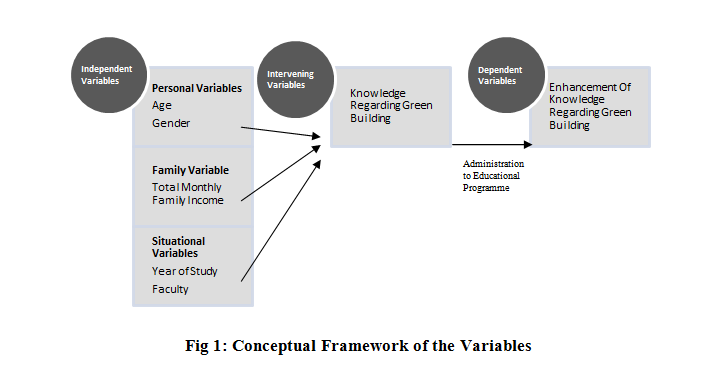
Enhancement of knowledge regarding Green Building is dependent variable for the present investigation (Fig 1). It is hypothesized that personal variables like age and gender of the respondents, family variable i.e. total monthly family income and situational variables like year of study and faculty, influences the knowledge of the respondents regarding Green Building which is an intervening variable for the study.
Sample Selection and Size
The samples were collected from youth of various faculties of Maharaja Sayajirao University, Vadodara. The students of different faculties were approached studying in first year, second year and third year, junior and senior master. A sample of 120 youth was collected through systematic random sampling technique.
Selection and Construction of Tool
Questionnaire was selected as a tool for collecting the information as the respondents were educated. Care was taken to incorporate all the needed information as decided in the formulated objectives of the study.
Description of the Tool
Questionnaire comprised of two sections. Section one comprised of questions regarding the background information of the respondents. Section two comprised of knowledge scale. A summated rating scale was developed to assess the knowledge of youth regarding various aspects of Green Buildings. Each statement had three responses viz. Correct, Incorrect and Do Not Know. For all the statements, the respondents had to put a tick mark on any one option. The knowledge scale was subjected to establishment of content validity by giving to the panel of five judges who were experts in the relevant field. The 80 per cent of the agreement between the judges was taken as a yardstick for inclusion/omission of the statement in the final scale. The reliability was established through split half method. Spearman Brown correction formula was applied and reliability was found to be 0.68.
Development and Administration of Educational Programme
Content regarding Green Buildings was developed highlighting the meaning, features, benefits, need of Green Buildings and its aspects viz. Site selection, Water efficiency, Energy conservation, Material and Resources and Indoor Environmental Quality. The knowledge test was administered to the students first and then they were exposed to educational programme. The same knowledge test was administered again immediately after the exposure to educational programme. The score obtained on first administration and the second administration were subjected to paired t-test, so as to see the difference in level of knowledge between the first and the second administration.
Data Analysis Procedure
The collected data were categorized, tabulated and analyzed in terms of descriptive and relational statistics. Descriptive statistics used were frequency, percentages, mean while relational statistics employed in order to study the relationship between selected variables were coefficient of Correlation, t- test, Analysis of Variance (ANOVA) and paired t-test.
Results and Discussions
The findings of the study obtained through the analysis of the data supported with discussion and interpretations are presented as below:
Background Information of the Respondents
Background information included the personal and family information of the respondents. Family information included total monthly family income. It also included information regarding the year of study of the respondents and the faculty in which they used to study. Lastly it also dealt with sources of information of the respondents regarding Green Building.
Personal information of the respondents: Personal information of the respondents included their age and gender. Age and gender of the respondents were thought to be one of the variables affecting the knowledge of the youth on Green Buildings.
The age of the respondents ranged between 17 to 21 years. The respondent’s age was classified under three categories. The analysis of data in Fig 2 related to age and gender revealed that less than one half of the respondents were 20 or more years of age, more than one third of the respondents were 19 years old while rest of the respondents were 18 or less years old. The mean age of the respondents was 19.8 years. One half of the respondents were males and other half of the respondents were females.
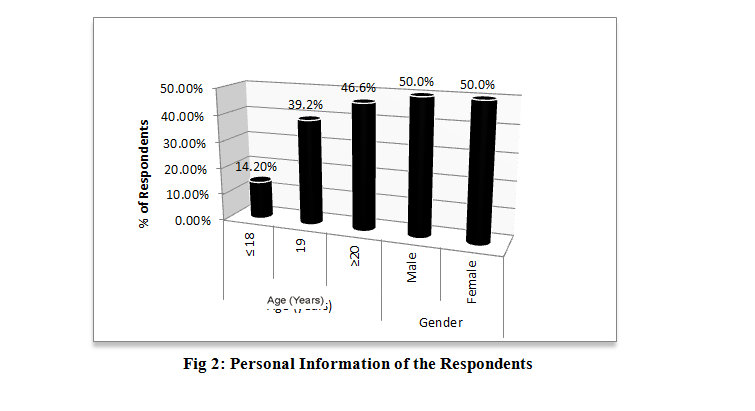
Family Information of the Respondents
Family information included fathers and mother’s occupation and total monthly family income. The occupation of the parents were categorized into three groups viz. service, business and self employed as father’s occupation while housewife, business and self employed as mother’s occupation.
Occupation of parents: The occupation of the mother and father of the respondents was categorized into three groups for each. The analysis as depicted from Fig 3, highlighted that less than one half of the respondents’ fathers were self employed. Almost 40 per cent of the respondent’s fathers were engaged in service sector and others were in business sector. Majority of the respondents’ mothers were housewives while very less were doing business and very small proportion i.e. 4.1 per cent of the respondents’ mothers were self employed.
Family income: In order to study the effect of total monthly family income on the knowledge of the respondents regarding Green Buildings, the information about total monthly family income was asked. The data in Fig 3 revealed that less than one half of the respondents’ monthly family income ranged between Rs. 15,000/- to Rs. 30,000/-. Less than one third of the respondents had total monthly family income above Rs. 30,0001/-. Rest (22.50 per cent) of the respondents’ total monthly family income was Rs. 15,001/-. The mean monthly income of the total sample was Rs. 37,129.167/- .
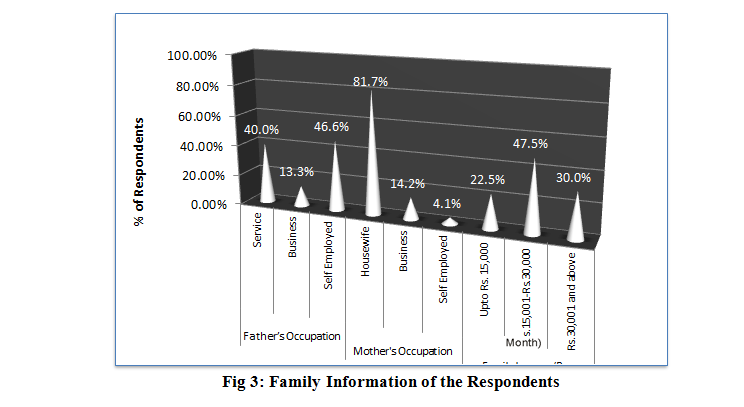
Year of study of respondents: The students of different years of study were selected as sample (Fig 4). More than two third of the respondents used to study in third year of their graduation degree. One fifth of the respondents were in second year.
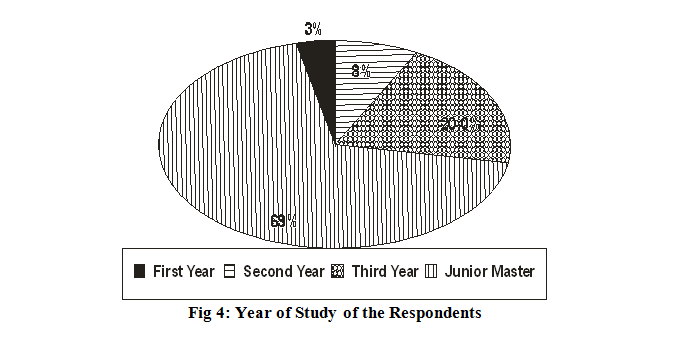
Level of knowledge regarding green buildings: Statements related to various aspects of Green Building such as meaning of Green Building, Site selection, Water efficiency, Energy efficiency, Materials and Indoor environment quality were formulated in the knowledge scale. Knowledge scale contained 42 statements which were positive as well as negative. The respondents were asked whether the statements were ‘Correct’, ‘Incorrect’ or they ‘Did not know’ about these. For positive statements, the score of ‘3’ was ascribed to the responses of correct, ‘2’ to incorrect and ‘1’ to do not know. For negative statements ‘3’ was ascribed to incorrect and ‘2’ was ascribed to the correct responses. The responses were summated to get a total score on a knowledge scale for each of the respondent. To find out the level of knowledge of the youth, minimum and maximum possible scores were divided among three categories having equal intervals. It was found in the present study that more than half of the respondents had medium level of knowledge regarding Green Buildings (Fig 5).
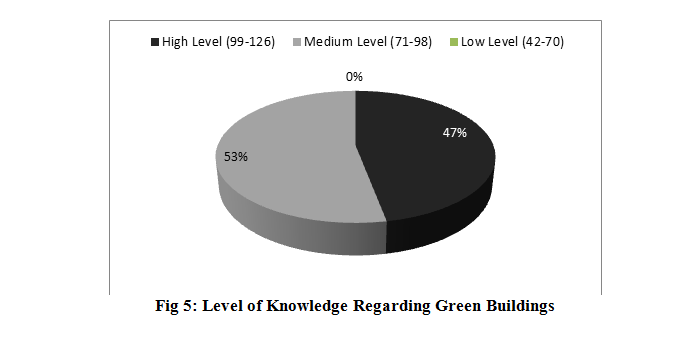
Testing of Hypotheses: Hypotheses were formulated on the basis of objectives of the study. For the purpose of statistical analysis, the hypotheses were formulated in the null form. The results are presented as follows:
Ho1: The level of knowledge regarding Green Buildings will not differ with the gender of the respondents.
To find out the difference in the level of knowledge regarding Green Buildings due to the gender of the respondents, t-test was computed.
The results showed that a significant difference in the level of knowledge of the youth regarding Green Buildings was found between male and female students. Hence, the null hypothesis was rejected (Table1).
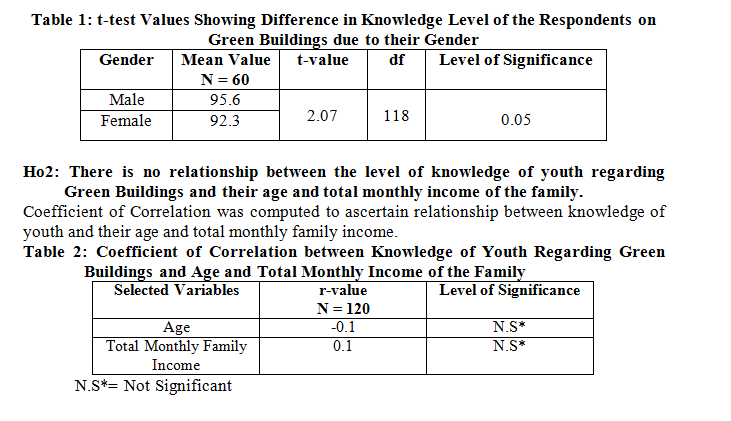
Computation of Coefficient of Correlation indicated that there was no significant relationship between knowledge of the youth regarding Green Building and age of the respondents and total monthly family income (Table 2). Hence the null hypothesis was accepted.
Ho3: There is no variation in the level of knowledge of the youth regarding Green Buildings with their year of study and faculty in which they Study.
To find out the variation in the level of knowledge of youth regarding Green Buildings with their year of study and faculty, Analysis of Variance was computed.
Computation of ‘F ’- ratio indicated that there was no significant relationship between knowledge of youth regarding green buildings and the faculty in which they study and the year of their studies (Table 3).Therefore, the null hypothesis was accepted.
Ho4: The level of knowledge regarding Green Buildings will not differ before and after the administration of the educational programme.
In order to find out the efficacy of the educational programme administered to the youth, paired t-test was computed on the obtained pre and post scores of the respondents on knowledge scale.
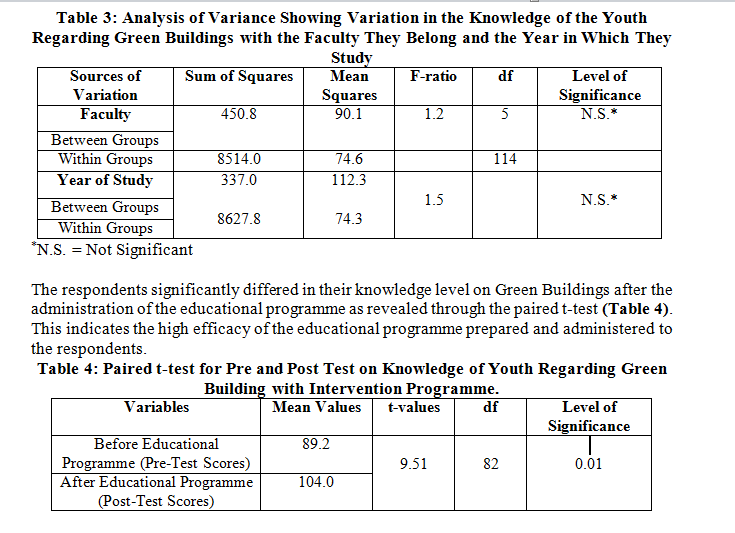
Conclusion
The study revealed that the knowledge level of the youth was found to be at moderate level. Therefore, there is a need to enhance the knowledge of the larger segment of the youth regarding Green Buildings. The educational institutions especially Family and Community Resource Management (FCRM) department can play a major role in imparting formal education to youth through structured curriculum and non-formal education to the present heads of the households and the homemakers, who are the major decision makers in relation to housing for the family.The net gain in the mean scores of knowledge test from first administration to the second administration reflected the efficacy of the educational programme. Hence, it can be utilized for enhancing the knowledge of the youth, homemakers and decision makers of the household.
References
Carter S (2008) Sustainable and Cost Effective. Times of India-July 20.
Desai A (2008) Green Building is Fast Catching on in India. Available at http://www.projectsmonitor.com/detailnews.asp?newsid=9753
Gou Z, Lau SSY and Zhang Z (2012) A Comparison of Indoor Environmental Satisfaction Between Two Green Buildings and a Conventional Building in China. Journal of Green Building 7(2): 89-104.
Indian Green Building Council (IGBC) (2011) Leadership in Energy and Environmental Design (LEED) for India- Green Building Rating System for New Construction and Major Renovations. Hyderabad: Confederation of Indian Industry.

